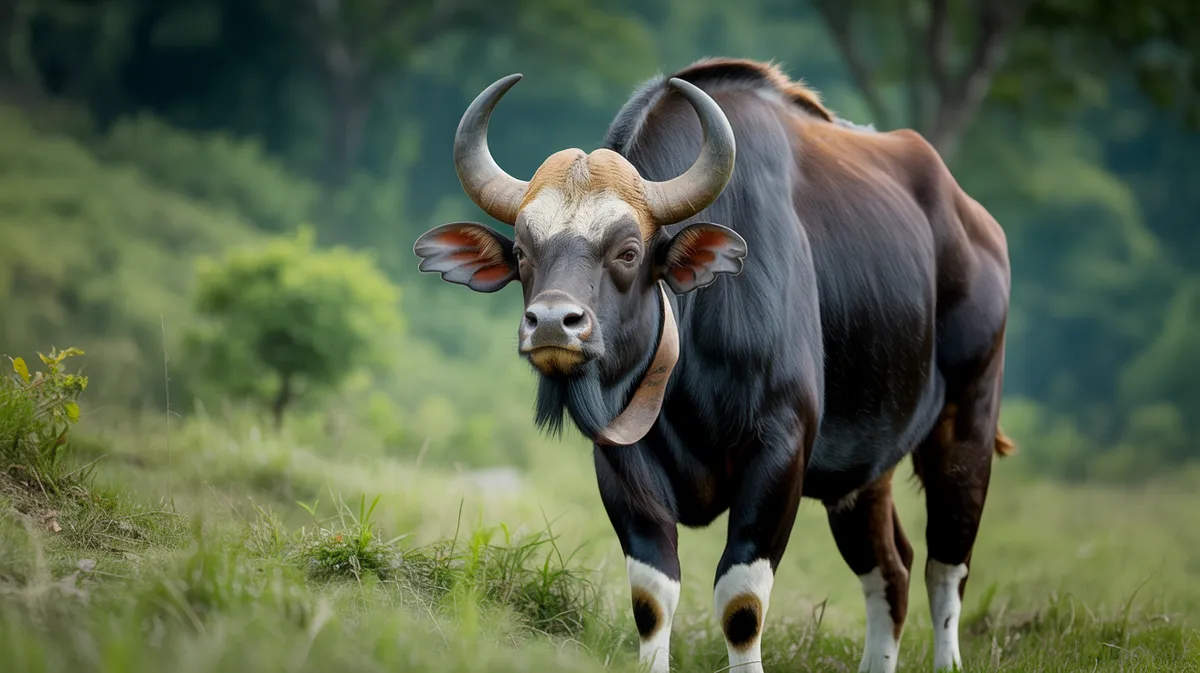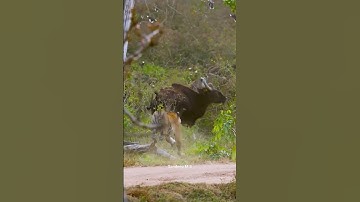
Gaur
Bos gaurus

Meet the Gaur
The gaur is the largest extant species of wild cattle, native to South and Southeast Asia. Recognized by its massive, muscular build, dark brown coat, and distinctive white 'stockings' on its lower legs, the gaur is an iconic denizen of forests and hilly terrain. Males are significantly larger than females and can weigh over a ton. Gaurs are shy and primarily crepuscular, grazing in herds and playing a vital role in shaping the forest ecosystem. Despite their impressive size and strength, they face threats from habitat loss, hunting, and disease transmission from domestic cattle.
Classification
Mammal
Habitat
Tropical and subtropical forests, grasslands, and hilly terrain
Diet
Herbivore
Lifespan
20-25 years
Conservation
Vulnerable
Weight
650–1,000 kg (1,430–2,200 lbs); large males up to 1,500 kg (3,300 lbs)
📖Fascinating Facts
Record-Breaking Size
The gaur is considered the largest of all wild cattle species, often surpassing even the wild African buffalo and American bison in size.
Forest Shapers
By feeding on grasses, leaves, and shoots, gaurs help maintain the balance of vegetation and promote new growth in their forest habitats.
Close Relatives
The domestic gayal (Bos frontalis) is believed to be a domesticated form of the gaur, developed in parts of Northeast India and Southeast Asia.
📋Detailed Description
The gaur (Bos gaurus) is the largest living wild bovine, with adult males standing 170–220 cm at the shoulder and weighing between 1,000–1,500 kg, while females are typically smaller at 700–1,000 kg. Their robust bodies are covered in a dark brown to blackish coat, with mature bulls often appearing darker than cows. A prominent dorsal ridge and a large, muscular hump over the shoulders—formed by elongated vertebral processes—distinguish the species. Both sexes possess curved horns, which are pale at the base and darken towards the tips, measuring up to 115 cm along the curve. The legs are characteristically white or yellowish below the knees, creating a 'stocking' effect. Gaurs have large, broad muzzles and a dewlap on the throat and chest. Their keen senses of smell and hearing compensate for relatively poor eyesight. Highly social, gaurs typically form herds of 8–40 individuals, led by a dominant female, although solitary adult bulls are not uncommon. They are primarily crepuscular, feeding during early morning and late afternoon, and rest in dense cover during the heat of the day. Gaurs are important ecosystem engineers, influencing forest structure through their grazing and seed dispersal.
💡 Did you know?
Despite their bulk, gaurs are capable of running at surprising speeds and jumping tall obstacles when threatened.
🔬Research & Sources
Wikipedia Summary
The gaur is a large bovine native to the Indian Subcontinent and Southeast Asia, and has been listed as Vulnerable on the IUCN Red List since 1986. The global population was estimated at a maximum of 21,000 mature individuals in 2016, with the majority of those existing in India. It is the largest species among the wild cattle and the Bovidae.
Last Modified: 5/9/2025
🎭Behavior & Social Structure
Gaurs are primarily grazers but also browse on shrubs, leaves, fruits, and bamboo, displaying a flexible diet that allows them to exploit a variety of habitats. Herds are matriarchal, usually composed of related females and their offspring, with adult males joining only during the breeding season or remaining solitary. Social interactions are generally peaceful, with dominance hierarchies established through displays and occasional sparring. Communication includes vocalizations such as snorts, bellows, and low moos, as well as visual signals like head tossing and body posturing. Gaurs are shy and elusive, avoiding human contact and retreating into dense forest when disturbed. They follow established trails to water sources and feeding grounds, and frequently wallow in mud to regulate body temperature and deter parasites. Predation risk comes mainly from tigers and, to a lesser extent, leopards and dholes, especially for calves.
👶Reproduction & Life Cycle
Gaurs breed year-round, but most births occur during the dry season (November–March) in India and Southeast Asia. Courtship involves males following and guarding receptive females, with ritualized displays and occasional fights between rival bulls. After successful mating, the gestation period lasts approximately 270–280 days (about 9 months). Females usually give birth to a single calf, rarely twins, in secluded areas within dense vegetation. Calves are precocial and able to stand within an hour of birth, joining the herd after a few days. Maternal care is pronounced, with mothers nursing and protecting their young for up to 9 months. Sexual maturity is reached at 2–3 years for females and 3–4 years for males, though males may not breed until they can compete successfully for mates.
🛡️Adaptations & Survival
The gaur's massive size and muscular build serve as deterrents against most predators, while their curved horns provide effective defense. Their dark coloration aids in camouflage within dense forests, and the white leg markings may play a role in intra-species recognition. The prominent dorsal ridge and shoulder hump support powerful neck and forelimb muscles, facilitating movement through thick vegetation and steep terrain. Gaurs possess a large, multi-chambered stomach adapted for fermenting fibrous plant material, allowing efficient extraction of nutrients from coarse grasses and leaves. Behavioral adaptations include crepuscular activity to avoid midday heat and wallowing to manage parasites and temperature. Social structure and group vigilance enhance predator detection and defense.
📚Research Sources
🎨Cultural Significance
The gaur holds significant cultural value in several Asian societies. In India, it is sometimes referred to as the 'Indian bison' and features in local folklore and tribal traditions, symbolizing strength and resilience. In parts of Southeast Asia, the gaur is associated with forest spirits and is occasionally depicted in traditional art. Historically, gaurs have been hunted for their meat and horns, which are used in ceremonial objects and tools. In some regions, domesticated forms known as 'gayal' or 'mithun' have been developed, playing important roles in local economies and rituals.
🔬Recent Research & Discoveries
Recent studies have focused on gaur population genetics, revealing moderate genetic diversity but highlighting concerns over habitat fragmentation and inbreeding in isolated populations. Camera trap surveys and GPS collaring have improved understanding of their spatial ecology, home range sizes, and habitat preferences. Research on disease ecology emphasizes the risk of pathogen spillover from livestock. Conservation programs are increasingly using community-based approaches and habitat restoration to support gaur populations. Ongoing studies are investigating the impacts of climate change on gaur distribution and resource availability.
🎥Wildlife Videos

Male Tiger from Bandipur hunting Indian Gaur #wildlife #nature #tiger
Divine Wildlife

GAUR ─ Tiger Killer on Steroids
Discover the true king of the jungle and the true inspiration behind Red Bull - the Gaur. With its muscular build and powerful horns, ...
BEASTERS

World's Biggest Wild Cows - Dangerous Gaur of India
In 2009, while in South India, I joined a researcher studying Wild Gaur, the world's largest species of wild cattle. A herd was ...
What on Earth!

Gaur - Return of the Giants | Full Movie | Reintroduction of Gaurs in Sanjay Tiger Reserve
In the heart of Central India, lies a pristine forest – a coffer of biological wealth, with unmatched floral and faunal diversity. Sanjay ...
Madhya Pradesh Tiger Foundation Society

Gaur: The Beast Even Tigers Fear
Gaur: The Beast Even Tigers Fear Discover the incredible strength of the gaur, nature's ultimate muscle machine. Known as the ...
Wildfree Nature

Indian Gaur also known as Indian bison roaming in the Forest | Nature’s Gentle Giants | Documentary
The sight of Indian Gaurs roaming freely in the forest is a testament to the wild beauty and strength of nature, reminding us of the ...
Divine Wildlife
🌍Habitat Information
The Gaur typically inhabits Tropical and subtropical forests, grasslands, and hilly terrain environments. Gaurs have adapted to their environments with specialized features and behaviors.
Primary Habitat:
Tropical and subtropical forests, grasslands, and hilly terrain
More detailed habitat information will be available soon.
🛡️Conservation Status
The Gaur is currently classified as Vulnerable. Conservation efforts are crucial for preserving this species for future generations.
Common Threats:
- 🏠Habitat loss and fragmentation
- 🌡️Climate change impacts
- 🎯Hunting and poaching
- 🏭Human-wildlife conflict
⚠️Threats & Conservation Challenges
Major threats to gaur populations include habitat loss and fragmentation due to agricultural expansion, logging, and infrastructure development. Poaching for meat, horns, and traditional medicine remains a concern in some regions. Disease transmission from domestic cattle, such as rinderpest and foot-and-mouth disease, poses significant risks. Human-wildlife conflict arises when gaurs raid crops, leading to retaliatory killings. Despite legal protections, enforcement is often weak, and populations outside protected areas are declining. The global population is estimated at 13,000–21,000 mature individuals, with the majority in India. Conservation challenges include maintaining genetic diversity, securing habitat corridors, and mitigating disease and conflict.
🔬Scientific Classification
Scientific Name
Bos gaurus
Classification Hierarchy
🔍 About Taxonomic Classification
Taxonomic classification is a hierarchical system used by scientists to classify and organize living organisms based on shared characteristics and evolutionary relationships.
The system moves from broad categories (Kingdom) to increasingly specific ones, with each animal's scientific name typically consisting of its Genus and species.
📝Community Notes
Share your observations and insights about the Gaur with our community of wildlife enthusiasts.
Join Our Community
Sign in to share your observations and connect with fellow wildlife enthusiasts.
Sign In to ContributeNo community notes yet
Be the first to share your observations about the Gaur!
Explore Gaur
Select a tab above to learn more about this amazing animal.
📸Photo Gallery
No photos available for this animal yet.
🌟Discover More Wildlife
Continue your journey of discovery with more fascinating animals from our database
